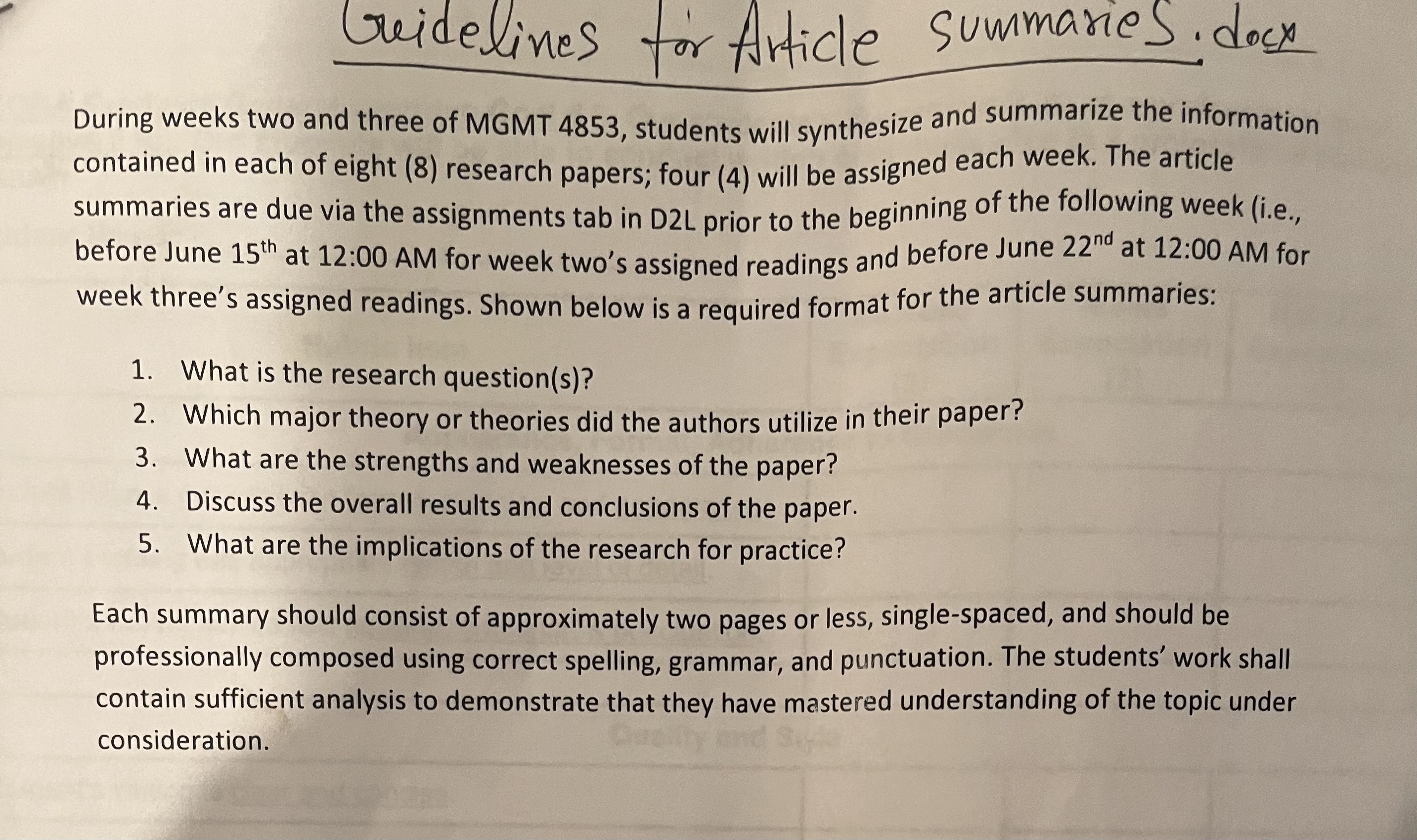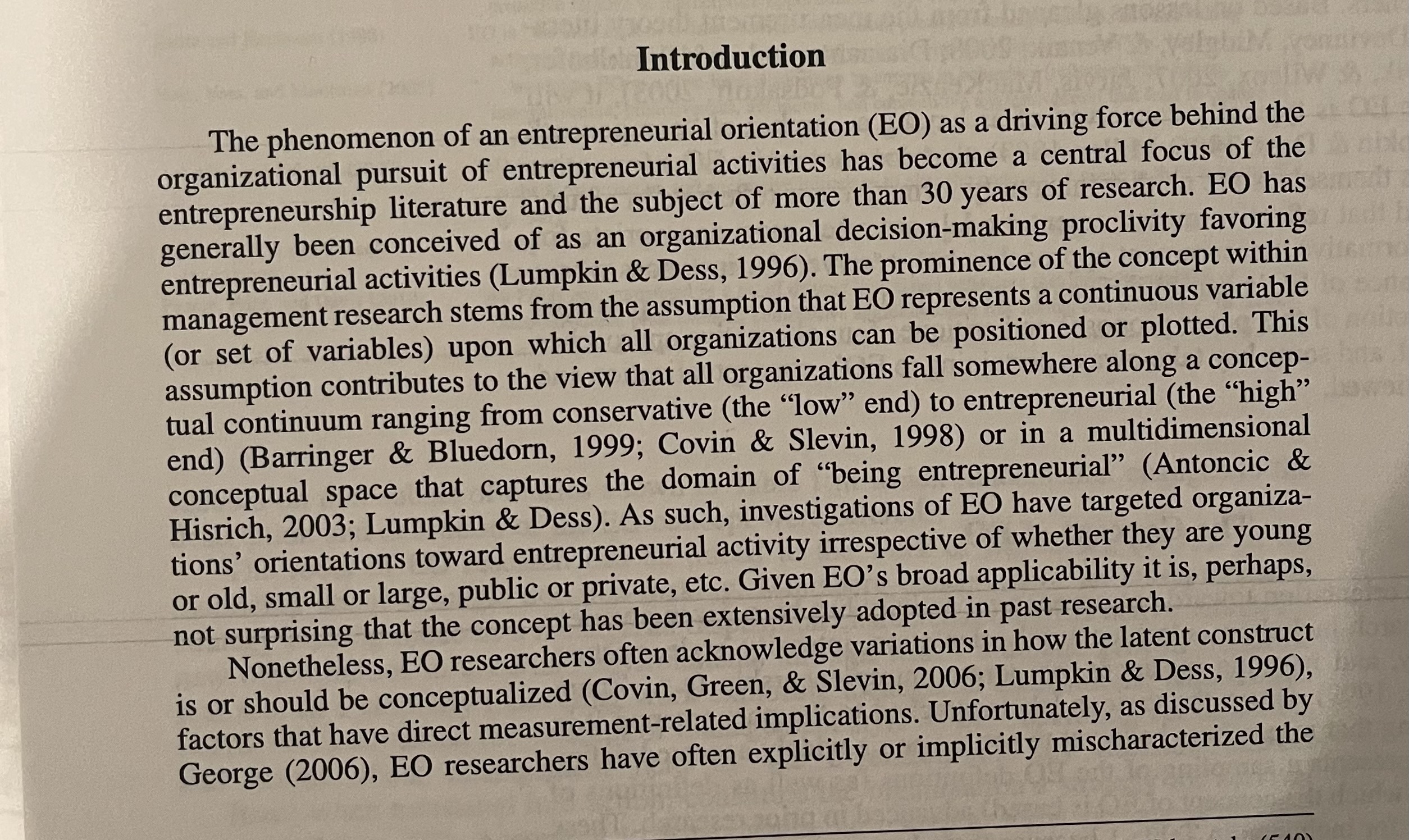Answered step by step
Verified Expert Solution
Question
1 Approved Answer
During weeks two and three of MGMT 4853, students will synthesize and summarize the information contained in each of eight (8) research papers; four (4)

 During weeks two and three of MGMT 4853, students will synthesize and summarize the information contained in each of eight (8) research papers; four (4) will be assigned each week. The article summaries are due via the assignments tab in D2L prior to the beginning of the following week (i.e., before June 15th at 12:00 AM for week two's assigned readings and before June 22nd at 12:00 AM for week three's assigned readings. Shown below is a required format for the article summaries: 1. What is the research question(s)? 2. Which major theory or theories did the authors utilize in their paper? 3. What are the strengths and weaknesses of the paper? 4. Discuss the overall results and conclusions of the paper. 5. What are the implications of the research for practice? Each summary should consist of approximately two pages or less, single-spaced, and should be professionally composed using correct spelling, grammar, and punctuation. The students' work shall contain sufficient analysis to demonstrate that they have mastered understanding of the topic under consideration. The phenomenon of an entrepreneurial orientation (EO) as a driving force behind the organizational pursuit of entrepreneurial activities has become a central focus of the entrepreneurship literature and the subject of more than 30 years of research. EO has generally been conceived of as an organizational decision-making proclivity favoring entrepreneurial activities (Lumpkin \& Dess, 1996). The prominence of the concept within management research stems from the assumption that EO represents a continuous variable (or set of variables) upon which all organizations can be positioned or plotted. This assumption contributes to the view that all organizations fall somewhere along a conceptual continuum ranging from conservative (the "low" end) to entrepreneurial (the "high" end) (Barringer \& Bluedorn, 1999; Covin \& Slevin, 1998) or in a multidimensional conceptual space that captures the domain of "being entrepreneurial" (Antoncic \& Hisrich, 2003; Lumpkin \& Dess). As such, investigations of EO have targeted organizations' orientations toward entrepreneurial activity irrespective of whether they are young or old, small or large, public or private, etc. Given EO's broad applicability it is, perhaps, not surprising that the concept has been extensively adopted in past research. Nonetheless, EO researchers often acknowledge variations in how the latent construct is or should be conceptualized (Covin, Green, \& Slevin, 2006; Lumpkin \& Dess, 1996), factors that have direct measurement-related implications. Unfortunately, as discussed by George (2006), EO researchers have often explicitly or implicitly mischaracterized the
During weeks two and three of MGMT 4853, students will synthesize and summarize the information contained in each of eight (8) research papers; four (4) will be assigned each week. The article summaries are due via the assignments tab in D2L prior to the beginning of the following week (i.e., before June 15th at 12:00 AM for week two's assigned readings and before June 22nd at 12:00 AM for week three's assigned readings. Shown below is a required format for the article summaries: 1. What is the research question(s)? 2. Which major theory or theories did the authors utilize in their paper? 3. What are the strengths and weaknesses of the paper? 4. Discuss the overall results and conclusions of the paper. 5. What are the implications of the research for practice? Each summary should consist of approximately two pages or less, single-spaced, and should be professionally composed using correct spelling, grammar, and punctuation. The students' work shall contain sufficient analysis to demonstrate that they have mastered understanding of the topic under consideration. The phenomenon of an entrepreneurial orientation (EO) as a driving force behind the organizational pursuit of entrepreneurial activities has become a central focus of the entrepreneurship literature and the subject of more than 30 years of research. EO has generally been conceived of as an organizational decision-making proclivity favoring entrepreneurial activities (Lumpkin \& Dess, 1996). The prominence of the concept within management research stems from the assumption that EO represents a continuous variable (or set of variables) upon which all organizations can be positioned or plotted. This assumption contributes to the view that all organizations fall somewhere along a conceptual continuum ranging from conservative (the "low" end) to entrepreneurial (the "high" end) (Barringer \& Bluedorn, 1999; Covin \& Slevin, 1998) or in a multidimensional conceptual space that captures the domain of "being entrepreneurial" (Antoncic \& Hisrich, 2003; Lumpkin \& Dess). As such, investigations of EO have targeted organizations' orientations toward entrepreneurial activity irrespective of whether they are young or old, small or large, public or private, etc. Given EO's broad applicability it is, perhaps, not surprising that the concept has been extensively adopted in past research. Nonetheless, EO researchers often acknowledge variations in how the latent construct is or should be conceptualized (Covin, Green, \& Slevin, 2006; Lumpkin \& Dess, 1996), factors that have direct measurement-related implications. Unfortunately, as discussed by George (2006), EO researchers have often explicitly or implicitly mischaracterized the Step by Step Solution
There are 3 Steps involved in it
Step: 1

Get Instant Access to Expert-Tailored Solutions
See step-by-step solutions with expert insights and AI powered tools for academic success
Step: 2

Step: 3

Ace Your Homework with AI
Get the answers you need in no time with our AI-driven, step-by-step assistance
Get Started


